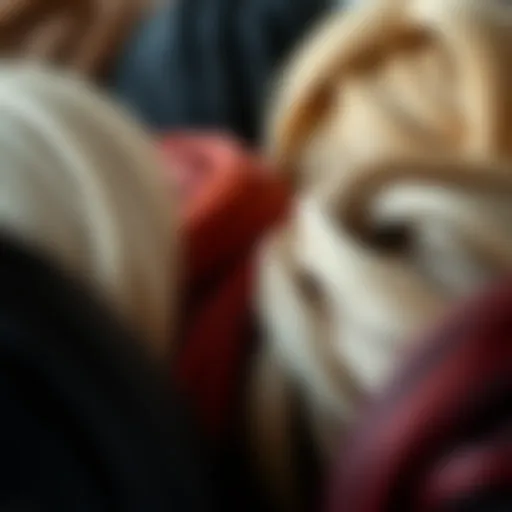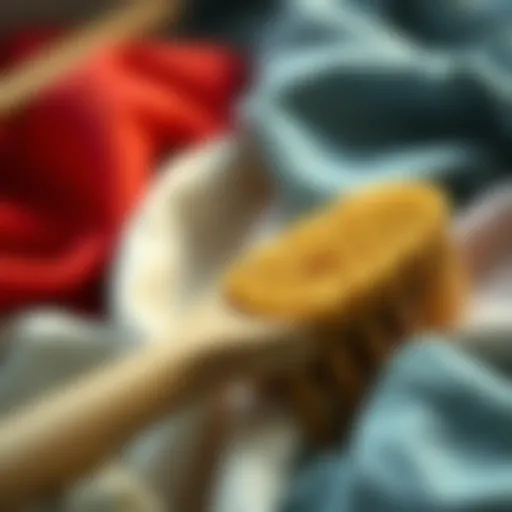Male Fashion Insights from The Great Gatsby
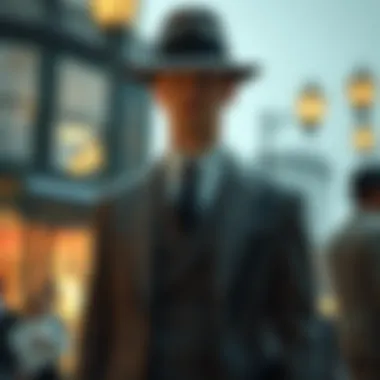

Intro
The world of F. Scott Fitzgerald’s The Great Gatsby offers not just a diving board into the glitzy jazz age of the 1920s, but also a profound look at how the costumes adorn the characters, revealing their identities and aspirations. No character embodies this more than the men, dressed in tailored suits that echo an era of elegance and extravagance. Each outfit serves a purpose—whether to flaunt wealth or to convey deeper social commentary. In this guide, we will traverse the fabric choices and color palettes so synonymous with this timeless narrative, helping enthusiasts and professionals alike appreciate and replicate those sartorial selections.
Fabric Knowledge
Understanding fabric is essential when embracing the sophistication of Gatsby-style attire. The textures and materials used in the 1920s not only provide aesthetic charm but also denote social status and personal taste.
Types of Fabrics
- Wool: A staple of the period, wool was used for suits and trousers. It is durable and can be woven in various ways, giving a range of finishes from coarse to fine. For the more formal look, opt for lightweight wool in charcoal or navy.
- Silk: Often used for ties and linings, silk embodies luxury. It drapes beautifully and is available in a multitude of colors, giving a rich sheen that elevates any outfit. Vintage ties often feature intricate patterns.
- Cotton: Often seen in summer attire, such as dress shirts, cotton is breathable and easy to care for. A crisp white cotton shirt pairs perfectly with blazers or vests.
- Linen: An ideal choice for those sweltering summer days, linen suits are lightweight but have a relaxed look. Keep in mind, linen wrinkles easily so a bit of history may show!
- Velvet: For a statement piece, velvet suits or blazers add a luxurious texture and depth. Perfect for evening wear, it can help a gentleman stand out at a gathering.
How to Care for Different Fabrics
Maintaining these fabrics is crucial to keeping your wardrobe looking fresh. Here are some tips:
- Wool: Dry clean only to avoid shrinkage. To keep the shape, store on wooden hangers with enough space between items.
- Silk: Hand wash with cold water; never wring out. Air dry away from direct sunlight to prevent fading.
- Cotton: Machine wash on a gentle cycle. Iron on medium setting for a crisp finish.
- Linen: Similar to cotton, but be prepared for some wrinkling, which is part of its charm. Machine wash cold.
- Velvet: Dry clean to maintain its lush appearance. Always store in a cool, dry space protected from moths.
Style Tips
Translating the fashions of The Great Gatsby into contemporary wardrobes requires insight into pairing and seasonal trends.
Outfit Pairing Strategies
To capture that classic Gatsby look:
- A well-fitted suit jacket over a crisp white shirt is a must.
- Layer with a vest for that dapper feel; muted colors work well with patterns to avoid clashing.
- Accessories matter: A silk pocket square can accentuate your tie while completing the look.
- Shoes should be polished leather—consider brogues for a dash of flair.
Seasonal Fashion Trends
Understanding seasonal trends will help keep your Gatsby-style looks relevant:
- Spring/Summer: Light colors and breathable fabrics dominate. Pastel suits and linen trousers allow for comfort in warmer weather. Think of Gatsby’s summer parties on the lawn.
- Fall/Winter: Opt for deeper hues like burgundy and navy with heavier fabrics. Layering is key; think wool overcoats and scarves.
"Fashion should be a form of escapism, and not a form of imprisonment." – Alexander McQueen
By considering fabric choices and pairing strategies, one can truly embody the essence of the characters in The Great Gatsby. This is not merely about wearing older styles but understanding their societal implications and the stories they tell. For further reading: Wikipedia or Britannica. A good understanding and appreciation of these elements will allow anyone to step into the shoes of a dapper gentleman from the Roaring Twenties.
The Cultural Impact of Costume in The Great Gatsby
The costumes crafted for F. Scott Fitzgerald's The Great Gatsby do far more than simply serve as stylistic embellishments; they operate as critical extensions of the characters themselves and mirrors reflecting the societal changes of the era. The male costumes, in particular, depict the lavish lifestyle and moral ambiguity of the Roaring Twenties. Just as much as the characters' dialogues or actions, the clothing they wear is pregnant with meaning, offering insights into their aspirations, wealth, and identities.
Historical Context of the Roaring Twenties
To fully grasp the importance of male costumes in The Great Gatsby, one must delve into the historical backdrop of the 1920s—a decade marked by colossal shifts in culture and society. Following the end of World War I, America experienced an economic boom that birthed a unique social landscape where traditional norms began to evaporate. It was a time characterized by jazz music, speakeasies, and the rise of consumerism.
Fashion in this period embraced flamboyance and extravagance, breaking away from the somber tones of previous decades. The tailored suit, for instance, transformed into a signifier of not just wealth but also of confidence. Male characters in the novel donned outfits that exuded sophistication, such as Gatsby's perfectly fitted three-piece suits or Tom Buchanan’s authoritative get-ups—embodying the very essence of the era's lavishness.
The Role of Fashion in Character Development
In this narrative, costumes are strategic tools for character development. The authors of the era understood that clothes often speak louder than words. Jay Gatsby’s wardrobe consists of dazzling ensembles that reflect his self-made fortune and his yearning to be accepted by the elite. His choice of attire often communicates his emotional undercurrents—the blues and greens he wears symbolize not just wealth but his longing for the unattainable.
In sharp contrast, Tom Buchanan’s fashions represent power. His opulent suits, often in dark shades, subtly underscore his authoritative and unyielding nature. It can be argued that his clothing helps reinforce the social hierarchy of the period, separating those like him from the likes of Nick Carraway, who opts for a more subtly elegant approach in outfits that embody casual sophistication.
Costumes in The Great Gatsby are not merely fabric stitched together; they narrate tales of ambition, social status, and dreams, weaving rich narratives that elevate the characters beyond the page.
By analyzing these sartorial choices, we gain insight into how fashion acts as a language, offering a visual representation of the characters' inner struggles and desires. Ultimately, the costumes in The Great Gatsby do much more than outfit the characters; they reveal the intricate relationship between social identity and fashion in the cultural tapestry of the Roaring Twenties.
Key Male Characters and Their Signature Styles
In F. Scott Fitzgerald's "The Great Gatsby," the sartorial choices of the male characters are not mere embellishments but pivotal elements that drive home the themes of wealth, ambition, and identity. Each character’s style reflects not just their socioeconomic status but also their inner lives, aspirations, and the societal expectations of the 1920s. This section uncovers the distinctive styles of three principal characters: Jay Gatsby, Tom Buchanan, and Nick Carraway, providing insights into how their wardrobes serve as visual narratives, enriching our understanding of their respective roles and the underlying societal commentary.
Jay Gatsby: The Epitome of Elegance
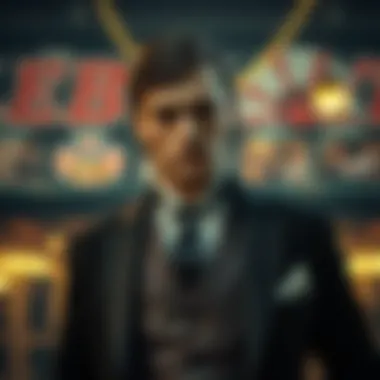

Defining Features of Gatsby’s Wardrobe
Jay Gatsby's wardrobe breathes extravagance and sophistication, a wardrobe that mirrors his aspirations and enigmatic persona. His penchant for sharp, tailored suits, often in light hues, underscores his attempt to project an image of success. One of the defining features of Gatsby's style is the meticulous fit of his suits, which not only emphasizes his physique but also suggests his meticulous nature.
Being a gentleman of substance, Gatsby embraces fine materials—wool, silk, and smooth cottons. This deliberate choice demonstrates a refined taste, aligning with the article's exploration of the connection between fashion and identity. Gatsby’s wardrobe distinctly communicates his status, but it also raises questions about authenticity and the illusions he constructs around himself. The unique blend of quality and style in Gatsby’s attire is a consideration for any modern interpretation of 1920s fashion. Understanding this helps modern fashion enthusiasts capture the essence of Gatsby—both the charm and the deceit.
The Symbolism Behind Gatsby's Attire
Gatsby’s outfits are not mere clothes; they are laden with symbolism that speaks volumes about his aspiration for acceptance in a world that is not entirely his own. The choice of colors, especially the iconic pastel shades, symbolizes hope and dreams. Each ensemble serves a purpose, reflecting key moments in the narrative, such as his infamous green light.
This symbolism of attire in "The Great Gatsby" acts as a critical bridge between appearances and the deeper themes of longing and despair that permeate the text. It illustrates that fashion, while enchanting, can also be a facade. For the savvy reader or fashion expert, understanding this layer of meaning amplifies the significance of Gatsby's choices. While stylish, these outfits encapsulate the tension between reality and illusion, offering a cautionary tale for those enamored with superficial appearances.
Tom Buchanan: The Archetype of Wealth
Understanding Tom's Power Dressing
Tom Buchanan epitomizes the aggressive confidence of old money, reflected in his wardrobe, which echoes elitism and entitlement. Tom’s power dressing consists of robust, assertive styles; he favors darker, bolder colors that resonate with his domineering personality. He often opts for heavily structured suits, enhancing his formidable presence.
The key characteristic of Tom's approach lies in his candid rejection of subtlety. His clothing embodies authority, aligning seamlessly with the social hierarchies of the time. This aspect of Tom's wardrobe is beneficial for illustrating how fashion can confer dominance in social situations.
However, Tom’s choice is not without its drawbacks; the suffocating aura of his powerful attire can be off-putting, isolating him from genuine connections. Therefore, exploring Tom’s style gives fashion enthusiasts a glimpse into the complex interplay between clothing, social status, and personal relationships.
Fabric Choices and Their Implications
When dissecting Tom’s fabric choices, one notices a stark reliance on heavier materials such as tweed and heavyweight wool, which further cement his persona of strength and stability. The implications of using such fabrics extend beyond mere aesthetic; they signify a traditional, entrenched class that resists change. This reliance on sturdy materials emphasizes a refusal to adapt, reflective of Tom's character in broader societal themes.
The unique feature of these fabric choices lies in their unmistakable quality, highlighting Tom’s wealth. This rich texture is appealing and asserts a sense of superiority. Yet, in modern interpretations, it can also serve as a reminder that such choices can be constraining—symbolizing a character ensnared by the very wealth he celebrates. This nuanced understanding challenges readers and stylists alike to ponder the deeper meanings behind sartorial elegance versus gilded cages.
Nick Carraway: The Observer’s Perspective
Nick’s Casual Elegance
Nick Carraway, as the narrator, offers a different perspective on style—one that balances civility with casualness. His noteworthy yet understated approach consists of tailored blazers, often paired with comfortable yet stylish trousers. This careful thought he gives to his appearance reveals a character who, while observant, opts not for flamboyance, but for a practical elegance.
The key characteristic of Nick’s style is its adaptability; he flows seamlessly between the social gatherings of East Egg and the more relaxed West Egg. This flexibility highlights a significant benefit of his wardrobe: the ability to fit in without compromising his identity. For anyone studying 1920s fashion, Nick's choice serves as an example of how simplicity can evoke sophistication.
Styling Lessons from Nick's Outfits
Nick’s wardrobe holds several lessons for modern fashion. His knack for combining pieces�—like sharp jackets with nonchalant accessories—illustrates the art of balancing classic elegance with relaxed vibes. This style reflects an insightful understanding of social nuances, where less is often more.
While Nick's outfits may lack the opulent splendor of Gatsby's style, they resonate authenticity, making them applicable for today’s fashion enthusiasts seeking to interpret vintage themes without excessive ostentation. The unique feature of Nick’s understated wardrobe offers a refreshing reminder: sophistication need not scream for attention. It can whisper tales of style and presence through graceful, subtle choices.
Essential Elements of 1920s Male Fashion
The 1920s stand as a pivotal point in fashion history, especially for male attire. Tailoring, fabric choices, and overall aesthetics were influenced by cultural shifts and societal changes during this vibrant decade. Understanding these elements is crucial if one wishes to fully appreciate the male costumes depicted in F. Scott Fitzgerald's The Great Gatsby. Through the lens of this article, as we trace the outfits of characters such as Jay Gatsby and Tom Buchanan, it becomes evident that the details matter immensely. Each element serves as a key that opens the door to the era’s sophistication and class.
Tailoring Techniques of the Era
The Importance of Fit
Fit was king in the roaring twenties. Men tailored their suits to fit their figures closely, evoking an appearance of power and control. A well-fitted suit was not merely a choice; it was a statement. The silhouette emphasized the shoulders and tapered at the waist, showcasing an athletic physique without appearing overly restrictive. This was particularly popular among the elite who were keen on portraying an image of confidence and status.
The advantage of such fit is clear—it enhances a man's natural shape, leading to an impression of elegance. A downside, however, was the time and expense involved in custom fitting, which meant this luxury was available primarily to the well-off.
Suit Types and Patterns
Various suit types emerged during this decade, ranging from the classic three-piece to tweed jackets. The patterns included houndstooth, pinstripe, and checks that were often complemented with waistcoats. These sartorial choices reflected not just personal style, but also the socioeconomic status of the wearer. For instance, the pinstripe became synonymous with business acumen, especially in urban centers.
Often, the complexity of patterns communicated wealth—more intricate designs indicated a lavish lifestyle. However, wearing bold patterns might garner attention, making it a risky choice for some. Many preferred simpler styles to avoid standing out too much in a crowd, particularly in settings that required a more subdued approach.
Popular Fabrics and Materials
Wool, Tweed, and Their Characteristics
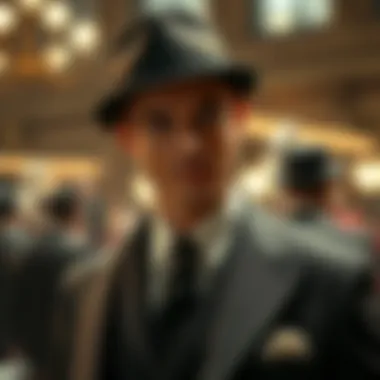

During the 1920s, wool and tweed reigned supreme as fabric choices for suits. Wool provided warmth and drape, making it a great option for varying temperatures throughout the day. Tweed was particularly favored during the colder months due to its rugged yet refined texture, adding an air of sophistication to leisure wear.
These fabrics breathed well, and their durability made them practical for daily wear. However, their heavier weight could feel cumbersome in warmer seasons, posing a challenge for style-conscious men.
The Revival of Silk and Satin
The return of silk and satin marked a turning point in men’s fashion, leading to a wave of luxurious evening attire. These fabrics were hailed for their luster and fluidity, making them ideal for more formal occasions such as Gatsby's infamous parties. Silk’s ability to maintain its shape while offering comfort made it a go-to for evening shirts and accessories, allowing men to express elegance with ease. Yet, due to their fragility, they were less practical for everyday use, often relegated to more private or exclusive events.
Color Palettes and Their Significance
Color plays a vital role in The Great Gatsby; it's not just about choosing a suit or tie. When you explore the male costumes, the selection of colors speaks volumes about the characters and their societal positions. Colors can evoke emotions, symbolize traits, and even hint at deeper narrative themes.
One can't overlook the fact that the colors chosen by Gatsby, Tom, and Nick serve as visual representation of their aspirations and realities. As you delve into this analysis, you'll notice how these palettes enhance your understanding of each character's journey and their standing in the social hierarchy of the 1920s.
In this bustling era, color complemented the excitement of newfound wealth and a break from tradition, making a significant statement. Moreover, understanding color palettes can guide you in replicating these iconic styles in your own wardrobe.
Understanding Colors in 1920s Fashion
In the 1920s, colors were notably vibrant, influenced by Art Deco and the luminescent flapper movement. Men’s fashion during this time wasn’t just about dark tones; brighter hues and rich shades like
- Royal blue
- Emerald green
- Bold reds
- Warm browns
These choices represented both individuality and masculinity, often breaking the mold of traditional color palettes that were more muted prior.
Moreover, the impact of color in this decade can’t be understated. Each shade carried a weight of meaning, reflecting the personalities and situations of the characters. From the lavish parties Gatsby threw to Nick’s understated style, the colors reinforced their distinctiveness and, at times, even foreshadowed their outcomes.
Signature Colors Worn by Male Characters
Bespoke vs. Off-the-Rack Choices
When it comes to fashion depicted in The Great Gatsby, understanding the choice between bespoke and off-the-rack suits can tell one much about social status and character attributes. Bespoke suits were crafted with precision to fit the individual, a hallmark of the elite class. Gatsby himself often donned tailored suits, embodying the aspirational spirit of his character.
A bespoke suit typically features:
- Unique fabric choices tailored to the wearer’s preferences
- A fit that accentuates personal physique
- Attention to detail, often with hand-stitched components
In contrast, off-the-rack options, while more accessible, often lack the individuality and superior fit of bespoke garments. They have their place in current times but can feel generic, particularly in a narrative filled with strong personalities. Opting for bespoke pieces can elevate one’s appearance and project an image of sophistication and wealth, aligning perfectly with the novel’s themes.
Color Symbolism in The Great Gatsby
Color symbolism in The Great Gatsby is deeply woven into the narrative. Different hues are associated with distinct themes—green for hope, white for elitism, and grey for the emptiness of wealth. Gatsby's famous green light is a prime example; it signifies not just his dreams of success but also alludes to the illusion of the American Dream.
When delving into this symbolism, consider:
- Green: Represents Gatsby's unattainable dreams and aspirations.
- White: Often worn by Daisy, indicating purity but also the superficial charm of the wealthy class.
- Grey: The desolate, lifeless Valley of Ashes embodies the moral decay hidden behind the glitz of the 1920s.
Understanding these color meanings enriches the reading experience, allowing a deeper connection to the characters and their motivations. It is not merely the costume that draws the eye but the hues that accompany them, forming a narrative thread through their sartorial choices.
"In this vibrant palette, Fitzgerald paints the contours of dreams and disillusionment, reflecting the depth and complexity of human aspirations."
This intricate analysis of colors and their meanings in The Great Gatsby aids in grasping both the fashion and the social commentary that defines this literary classic.
Accessories That Define Gatsby's Era
In F. Scott Fitzgerald's The Great Gatsby, the world of the 1920s is not only captured through the fabric and colors of the attire but also through the accessories that adorn the characters. These accessories play a pivotal role in expressing individuality, social status, and even the era’s cultural ethos. To truly embrace the essence of the time depicted in the novel, one must understand the subtleties of these sartorial accents.
Hats: A Staple of Male Attire
Headwear during the 1920s was not just a fashion statement; it was a symbol of prestige and style. Men in the novel and at the time often donned various types of hats that reflected their personalities and positions.
Types of Hats Worn by Male Characters
Among the many types of hats, the fedora stands out as a key accessory for men like Jay Gatsby. Fedoras often exhibited a wide brim and a tapered crown, commonly made from felt or straw. Their defining feature was the soft, flexible material which allowed for ease of wear and a comfortable fit. This made it a widely sought-after choice during the decade.
The benefit of the fedora lies in its versatility; it can effortlessly elevate a simple outfit while also providing a touch of mystery. However, it's worth noting that fedoras can sometimes be viewed as overly formal, depending on their styling.
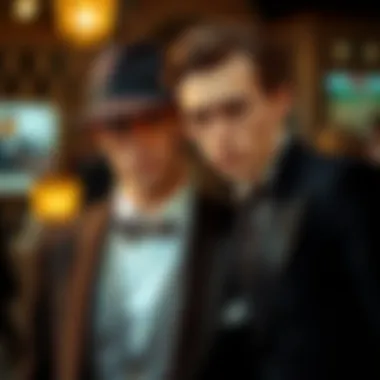

How Hats Influence Overall Style
Hats have the unique ability to transform an entire look, acting as the cherry on top of an outfit. They command attention and tell a story about the wearer. For instance, the fedora's slightly angled brim and band add a layer of sophistication that resonates with Gatsby’s elaborate persona.
Overall, hats like the fedora can evoke a sense of confidence; however, they can also detract from simpler outfits if not chosen with care. The main characteristic here is the hat’s capability to either complete an ensemble or overshadow it, depending on how it's styled.
The Impact of Footwear Choices
Footwear in the 1920s carried its own weight in terms of social commentary. Just as hats reflected one's status, shoes were equally telling, especially among the male characters in The Great Gatsby.
Types of Shoes during the 1920s
Footwear trends featured a range of styles, from polished Oxfords to more relaxed loafers. Oxfords, known for their close lacing and sleek appearance, were popular among the elite. Meanwhile, the loafers offered an easier slip-on option that appealed to the more casual or artistic types. A defining feature of Oxfords is their classic and understated elegance, making them a staple in a well-dressed man's wardrobe. However, they can sometimes feel overly formal for leisurely outings.
The Relationship Between Shoes and Social Class
Shoes were a visible marker of one’s socio-economic standing. Oxfords, often crafted from high-quality leather, conveyed affluence and taste. Their shine and craftsmanship indicated wealth and attention to detail, qualities aspired to by characters like Tom Buchanan. Conversely, loafers had a more relaxed connotation, often linked to the artistic and bohemian lifestyle. Understanding this dynamic provides key insights into character development; a well-chosen shoe can tell volumes about an individual’s place in society, both in the ’20s and today.
The Role of Accessories in Complete Outfits
Accessories are the finishing touches that tie a look together, hinting at the personality of the wearer. In The Great Gatsby, these elements contribute significantly to the overall visual narrative.
Use of Cufflinks and Tie Bars
Cufflinks and tie bars are vital components of a well-executed ensemble. Cufflinks can be simple or extravagant, often acting as a means of self-expression. Their defining feature is the ability to add a touch of luxury and elegance to an outfit. With Gatsby’s penchant for over-the-top display, these accessories become an essential part of his look, issuing both style and wealth to onlookers. While they elevate any ensemble, it’s crucial to choose the right design; missteps can lead to an ensemble that feels displeasing or chaotic.
Effects of Pocket Squares and Jewelry
Pocket squares and jewelry add intricate detail to men's outfits. A pocket square can easily be adjusted in color and style to harmonize with the rest of the attire. Its unique feature is that it introduces a dash of color or pattern, infusing personality into the outfit. On the other hand, jewelry, while less prominent, can signify personal milestones or family heritage. Both can serve to either highlight or muddle an outfit depending on their usage.
"Accessories provide the final polish that transforms well-constructed attire into something exceptional."
Modern Interpretations and Re-imaginings
In the context of The Great Gatsby, modern interpretations and re-imaginings of male costumes signify a bridge between the illustrious fashion of the 1920s and contemporary wear. By examining these modern takes, one can understand how the essence of Gatsby's world continues to resonate. The juxtaposition of timeless elegance with today's style nuances provides a fresh perspective that appeals to fashion enthusiasts and professionals alike. Through this lens, the originality of the 1920s becomes not merely a relic of the past, but a source of inspiration.
Adapting Gatsby’s Fashion for Today
Finding Modern Equivalents
Finding modern equivalents to Gatsby's iconic wardrobe is essential for those wishing to replicate his style while catering to current trends. This aspect emphasizes the fundamental idea that fashion is cyclical; elements from the past can seamlessly blend into modern couture. For instance, streamlined tailoring reminiscent of Gatsby can easily be found in contemporary suits. Key characteristics of these modern equivalents include:
- Sharp Silhouettes: Fitted suits that frame the body.
- Subtle Patterns: Checks or pinstripes that whisper sophistication without shouting.
- Luxe Fabrics: Wool blends mixed with silk for a refined finish.
The unique feature of finding modern equivalents lies in their accessibility. Retailers today offer variations that allow for personal expression, making them a popular choice. However, it's important to note that the challenge lies in ensuring these pieces maintain the spirit of the original while avoiding costumes that seem overly thematic.
"Fashion is what you’re offered four times a year by designers. And style is what you choose."
— Lauren Hutton
Creating Contemporary Gatsby-Inspired Outfits
When it comes to creating contemporary Gatsby-inspired outfits, one dives deeper into the synthesis of historical influence and modern practicality. This process not only honors the original styles but also breathes new life into them through innovation. A signature characteristic of these outfits is their versatility. For example:
- Layering Techniques: Using lighter fabrics to navigate seasonal changes.
- Casual Innovations: Mixing formal elements with streetwear, like pairing a waistcoat with chinos.
- Highlighting Accessories: Funky pocket squares or vibrant ties that reference the era without being overwhelming.
The distinctive nature of contemporary Gatsby-inspired outfits lies in their adaptability. They can be worn at various occasions, from formal events to casual gatherings. However, the downside may be the risk of diluting the iconic nature of Gatsby’s style if the essence is lost amid too many modern twists. Balancing homage to the past with a fresh context is crucial for achieving a striking yet respectful interpretation.
Finding a middle ground in adapting these fashions ensures that the elegance of The Great Gatsby remains pertinent, creating a lasting impact on how male outfits are perceived in the modern age.
Culmination: The Enduring Appeal of Gatsby Style
The Great Gatsby stands as not just a literary masterpiece but a pivotal cultural touchstone that profoundly influences fashion even today. The costumes, particularly those worn by male characters, are not mere fabric and thread; they encompass identity, status, and aspiration. This article has dissected the myriad elements of male costume design, shedding light on how each choice—from fabric to color—serves a narrative purpose. But why does this fashion resonate decades after the novel’s publication?
Why Gatsby Fashion Still Resonates Today
Gatsby’s fashion reflects an era of exuberance, hope, and, ultimately, disillusionment. The appeal of this style lies in several factors:
- Timeless Elegance: The sharp suits and dapper accessories defined an era of sophistication that seamlessly resonates with modern tastes. They exude a sense of class that often feels absent in today’s casual norms.
- Symbolism and Identity: Clothes in that period acted as status markers, much like today. The obsession with brand and identity remains deeply rooted; individuals draw connections to Gatsby’s lavish wardrobe, reflecting their personal aspirations through fashion.
- Cultural Relevance: Current events often mirror the themes found in Fitzgerald’s novel. The pursuit of the American Dream, class struggle, and unfulfilled desires find new life in today’s world, thereby reviving the conversation around the opulence represented in the Great Gatsby.
"In fashion, as in literature, what you wear can tell a story, crafting an identity that is ever-evolving yet rooted in history."
In practical terms, the ongoing revival of 1920s fashion—from high-profile events, themed parties, to runway shows—demonstrates that Gatsby's style has morphed into an annual trend. Stylists and retailers continue to draw from this reservoir, allowing a fresh yet familiar approach to men’s fashion that honors the past while looking toward the future.
To fully embrace Gatsby-inspired attire, one need not replicate the outfits wholesale but instead channel the spirit through tailored pieces, attention to fit, and thoughtful accessory choices. Each element—whether a well-fitted suit or a vintage pocket square—invites an exploration of self-expression while promoting a deeper cultural appreciation.



